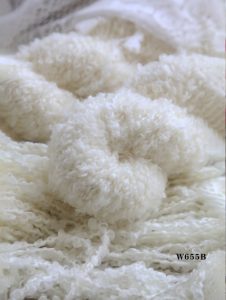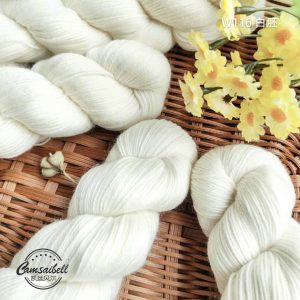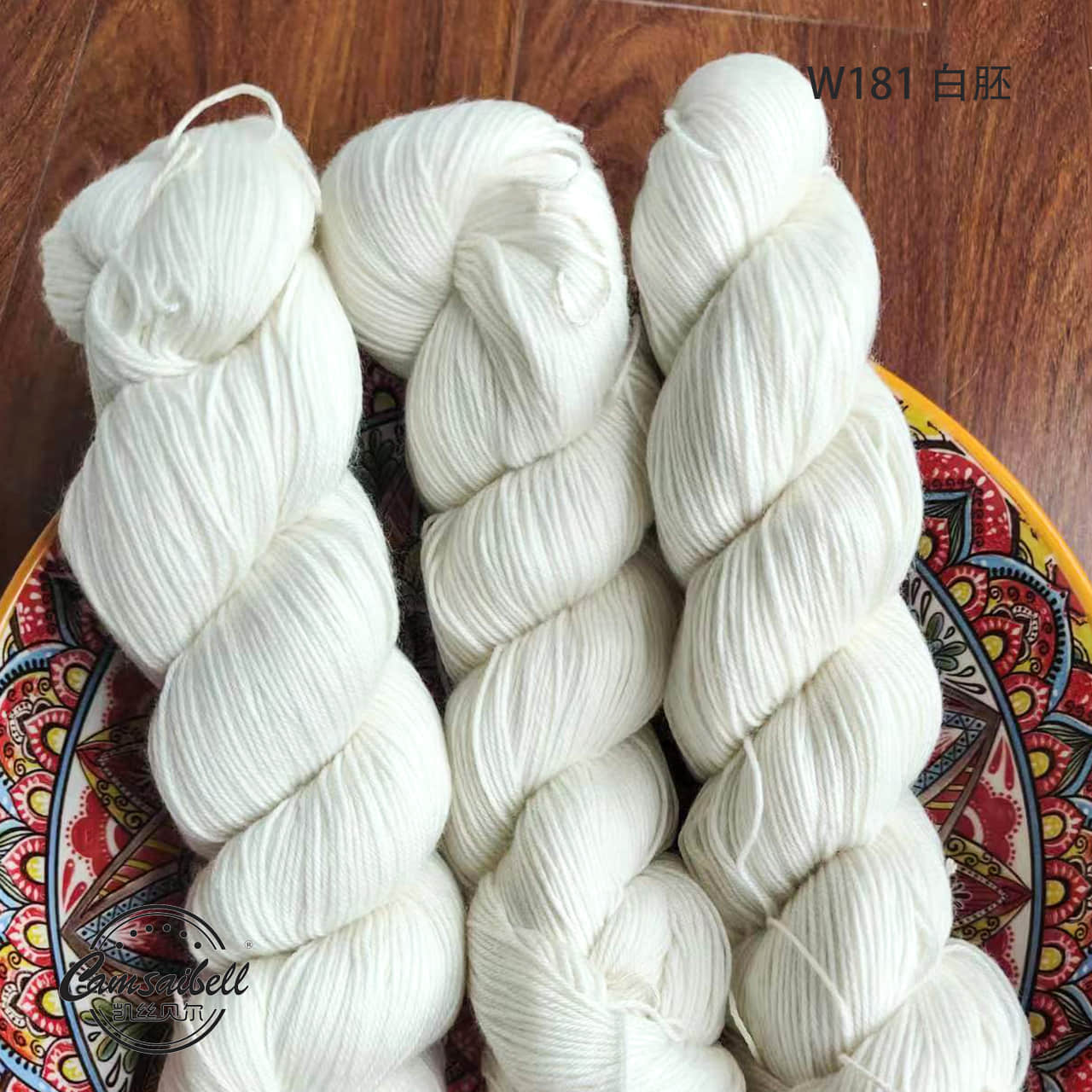Recently, the market demand for 염색되지 않은 원사 is still increasing. Undyed yarn is not just an intermediate product that has not been processed yet. It is a comprehensive embodiment of environmental protection concept, product flexibility and sustainable fashion. Its application field is also very wide. If you also need undyed yarn, you can come here to learn about it first. It can help you fully understand the market situation of undyed yarn and help you make a more wise choice!

What is undyed yarn?
Undyed yarn refers to yarn products that have not been dyed in any way. It usually retains the natural color of the fiber, such as milky white, light yellow, ivory, light brown, etc., reflecting the most natural and pure texture of the raw materials. This type of yarn can be directly used in textile, weaving, embroidery or dyeing and finishing processes, and is one of the important elements currently advocating environmental protection and sustainable textiles.
Unlike dyed yarn, the production process of undyed yarn does not contain synthetic dyes, auxiliaries or a large number of washing steps, which reduces the impact on the environment and is more suitable for consumers with sensitive skin or who insist on environmental protection.
Main ingredients of undyed yarn
The raw materials of undyed yarn are relatively wide, but they are mainly natural fibers and also contain some synthetic fibers. Common ingredients are shown in the following table:
| Fiber Type | Typical Content | Color Appearance |
| Cotton (Organic/Natural) | 100% cotton (combed or carded) | Ecru, pale cream, beige |
| Wool | 100% virgin wool or alpaca | Off-white, ivory, brown |
| Linen (Flax) | 100% linen or hemp | Greyish, earthy tone |
| Bamboo | Bamboo viscose or regenerated cellulose | Slightly translucent white |
| Silk (Raw or Tussah) | Pure silk, unbleached | Golden tan, creamy yellow |
| Acrylic/Polyester | Synthetic undyed forms | Bright white or off-white |
Note: “Undyed” yarn does not mean “unbleached”. Some products are mildly pre-treated to remove impurities, but no coloring is added.

Performance of undyed yarn
Undyed yarn maintains the natural structure of the original fiber, and its physical and chemical properties are relatively stable. It is particularly suitable for design or secondary processing projects that require high color autonomy of the fabric. Its main properties are as follows:
- High hydrophilicity and breathability: natural fibers such as cotton and linen have good moisture absorption and breathability;
- High softness: without high-temperature dyeing and finishing, the yarn is more fluffy and smooth;
- Strong environmental protection: does not contain chemical dyes, which is safer for the environment and human body;
- Good dyeing secondary processing: convenient for users to color or plant dye as needed later;
- Not easy to fade or yellow: some undyed yarns are treated at low temperature and have high stability;
- More natural feel and color layering: suitable for literary, retro, and rural style products.
Undyed yarn market price range
| Yarn Type | Material Composition | Price Range (USD/kg) | Grade |
| Organic Cotton Yarn | 100% natural cotton | $7 – $12 | OE / Ring Spun |
| Wool Yarn | Merino / Alpaca / Cashmere | $15 – $45 | Worsted / Semi-worsted |
| Linen Yarn | 100% flax or hemp | $9 – $18 | Wet spun / Dry spun |
| Bamboo Yarn | Bamboo viscose | $10 – $16 | Knitting grade |
| Silk Yarn | Tussah or raw silk | $30 – $60 | Reeled or spun |
| Acrylic Yarn | Undyed synthetic yarn | $4 – $8 | Bulk / Economy |
The price is affected by factors such as raw material grade, spinning process (ring spinning, air spinning, etc.), whether it has been pretreated, etc.
What is the use of undyed yarn?
Undyed yarn is widely used in the following major fields:
- Customized dyeing workshop: designers perform plant dyeing, hand dyeing, and soaking dyeing according to project requirements;
- Infant and toddler clothing: avoid dye allergies and ensure skin safety;
- Environmentally friendly textiles: such as GOTS and OEKO-TEX certified fabrics;
- Home textiles and wool knitting: blankets, cushions, pillows, wool hats, scarves, etc.;
- Hand knitting and crochet art: colors can be customized, with more creative freedom;
- Religious or natural philosophy clothing: community groups that pursue primitive, simple, non-chemically processed textures;
- Embroidery and fabric materials: blank white is convenient for creating colorful patterns.
Features of undyed yarn
- Strong original texture: retain the original breath of natural materials;
- Suitable for dyeing and secondary artistic creation: easy to match with natural plant dyes;
- Unique style: with natural texture color difference and mottled effect;
- Low allergy risk: does not contain chemical dyes, suitable for sensitive people;
- Multiple environmental label certifications: easy to obtain ecological certifications such as GOTS, organic cotton certification, etc.;
- Strong color stability: not easy to fade or migrate due to washing;
- Versatile style: suitable for minimalist, naturalistic, and retro designs.

Advantages of undyed yarn
- Environmentally friendly and sustainable: no pollution of water sources, no exhaust emissions;
- Reduce allergy risk: gentler on the skin;
- Suitable for high-end customization: free color matching, independent dyeing design;
- Adapt to multiple processes: weaving, knitting, sewing are all possible;
- Reflect natural texture: no additional decoration is required for aesthetic effects;
- Conform to consumer trends: green fashion and zero-carbon life concepts are becoming increasingly popular.
How to choose undyed yarn?
- Fiber Type: Choose according to the project: For example, cotton for baby products, wool or silk for artistic creations
- Hand Feel: Check the softness and velvet feel by hand
- Twist/Spinning: Pay attention to whether the yarn is smooth, knot-free, and has moderate torque
- Certification: Pay attention to organic and hazardous substance screening certification (such as GOTS, OEKO-TEX)
- Yarn Count (Ne/Tex): Choose the right count: thin yarn is suitable for fine weaving, and thick yarn is suitable for wool products
- Bleaching Status: Has it been oxygen bleached or bio-enzyme bleached? Is it completely untreated original color?
- Batch Consistency: Check whether the color difference is too large, especially when used for large areas of fabrics
- Source & Traceability: Understand whether the supply chain is traceable, especially for sustainable brands
Comparative analysis of undyed yarn and other dyed yarns
| Attribute | 염색되지 않은 원사 | Dyed Yarn |
| Environmental Impact | Low, water-friendly, no chemical dye pollution | High, high pollutants in dyeing and finishing, high carbon emissions |
| Skin Safety | High, suitable for sensitive skin or babies | Medium, depending on dye type and residual dosage |
| Flexibility | High, can be used for hand dyeing, plant dyeing | Low, fixed colors, lack of creative freedom |
| Color Fastness | Generally good (stable primary colors) | Color fastness depends on dyes and dyeing and finishing technology |
| Aesthetic Appeal | Natural color, original retro style | Vivid and rich, suitable for fashion and trendy products |
| Cost | Slightly higher (if organic) | Usually cheaper or mid-range |
결론
Undyed yarn is a type of yarn that combines environmental value, aesthetic characteristics and creative freedom. Especially in the contemporary textile industry where sustainable development is increasingly concerned, its status is constantly improving. Whether it is to meet the fashion trend of eco-friendly and environmentally friendly, or to meet the individual needs of artistic creation, undyed yarn is a material choice with broad prospects and practical application value.
For consumers and brands, scientific material selection, clear purpose, and combining their own ideas are the key to creating high-value-added textiles. If you pursue environmental protection, organic, free dyeing and natural beauty, undyed yarn will be a worthy choice.





